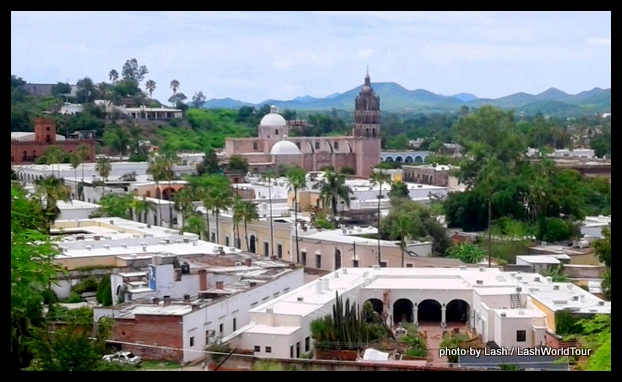
Alamos
Gorgeous Colonial Alamos – Sonora
Alamos is a small well-preserved Spanish colonial town in southern Sonora state. It’s one of Mexico’s 111 ‘pueblos magicos’ aka ‘magic villages’. Along with even smaller Magdalena del Kino further north (also a pueblo magico), Alamos is the only other colonial town in Sonora.
The two towns are considerably different, however, as Magdalena was founded and built in the early 1500s by a Jesuit Italian priest named Father Kino, while Alamos was created by the Spanish out of proceeds from nearby silver mines they discovered in the late 1600s.
Much of the historic, long-reigning Spanish conquest and development of Mexico was based around silver mines discovered in the central and western highlands in the early-mid 1500s.
The Spaniards built many gorgeous historic cities and towns all over the country from the vast wealth of those mines, but most are located in the central Mexican highlands.
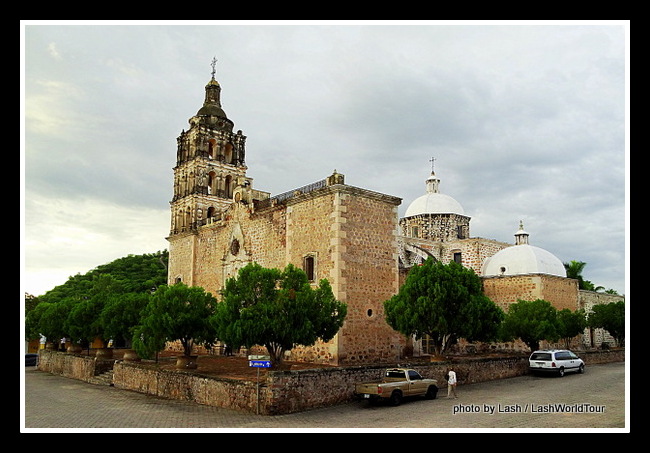
main cathedral in Alamos
Alamos is an oddball among them as it’s located considerably further north and, as mentioned, was not established until the late 1600s. Never the less, Alamos was built like other typical Spanish towns with an imposing stone cathedral set on a main central plaza that’s surrounded by long stately buildings featuring rows of columns set along wide, open stone-floored hallways.
Alamos also boats a stunning natural setting. It’s situated in a shallow bowl-shaped valley, completely surrounded by forested mountains with stunning silhouettes and rock formations.
Alamos’ historic center is very well preserved and consists of several blocks of original buildings that include private homes, boutique hotels, small restaurants & cafes and various shops.
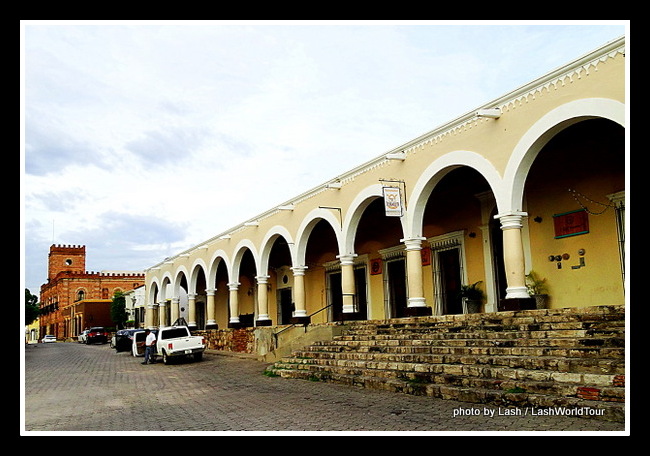
porticos on buildings lining Plaza del Armas in Alamos
Alamos is particularly famed for its many ‘porticos’ – those rows of columned external hallways fronting buildings.
Surprisingly, ‘in the know’ Americans started visiting Alamos way back in the 1950s and buying up the colonial houses there. Many of the restorations works around town were carried out by these new American owners.
For nearly 70 years already, Americans have been living in Alamos, at least part time during winter months. There’s a small and snug expat community of about 400 people. From October to about April, Alamos is a-buzz with a mix of Mexicans and North Americans.
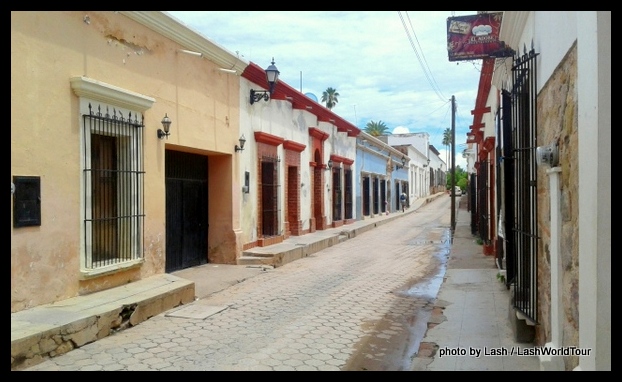
street in central Alamos –
But over-all Alamos still looks, feels and functions like a typical Mexican town, albeit a partially tourist-driven town. Alamos is equally popular with Mexican visitors who arrive in hordes on weekends and during the school holidays in July and August.
Near the leafy main plaza, down a narrow cobblestone alley, is the town’s central market set inside a long colonial building. It’s filled with fruit & vegetable stands and meal counters where typical Mexican foods are served all day long.
The far end of the market opens to a long, narrow green park plaza shaded by huge native trees and offering many stone sitting benches and low walls. This plaza – Plaza La Alameda – is also surrounded by historic buildings, these filled with small daily-needs shops, and is a popular place for aging cowboys to hang out and chat.
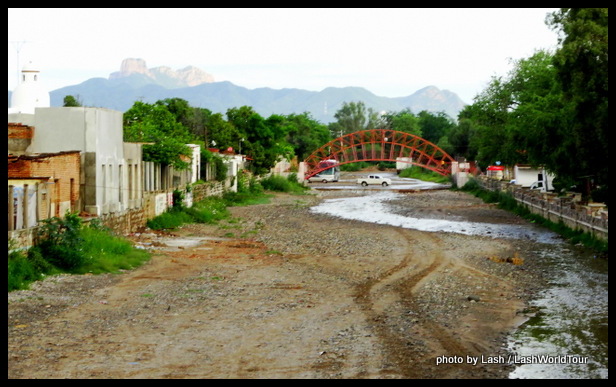 A very shallow stream runs along the edge of town near Plaza Alameda, marking the limit of the central historic town. Cars and trucks must all press right through the river from one side to the other.
A very shallow stream runs along the edge of town near Plaza Alameda, marking the limit of the central historic town. Cars and trucks must all press right through the river from one side to the other.
Pedestrians and cyclists can opt to cross over on one of several elevated arched bridges, though many people just wade through the stream when water levels are low. The stream and bridges offer more scenic views of the town and surrounding mountains.
Alamos’ streets run from the center up into the hills in many directions. Starting just a few blocks from the main plaza are many grand houses and haciendas, which continue on up the hillsides. Many have gorgeous views over the town, valley and mountains.
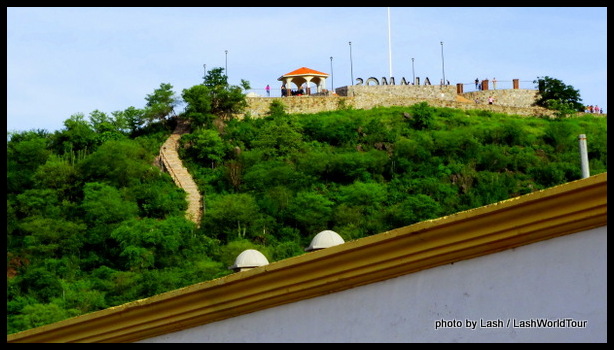
mirador of Alamos
On top of one hill close to town is a fantastic ‘mirador’ aka look-out point, with amazing 360 degree views over Alamos, its bowl-shaped valley and brilliant-green mountains in all directions.
Steep stone steps lead up the hillside to the top, an ascent of just 15-20 minutes. A road also winds up to the mirador, where a large parking lot accommodates visitors.
Alamos offers two great little museums. Museo Costumbrisa de Sonora, set on one side of the main plaza, showcases the history and culture of Alamos & Sonora. Casa and Museo de Maria Felix celebrate Mexico’s most famous historic movie star, who hailed from Alamos.
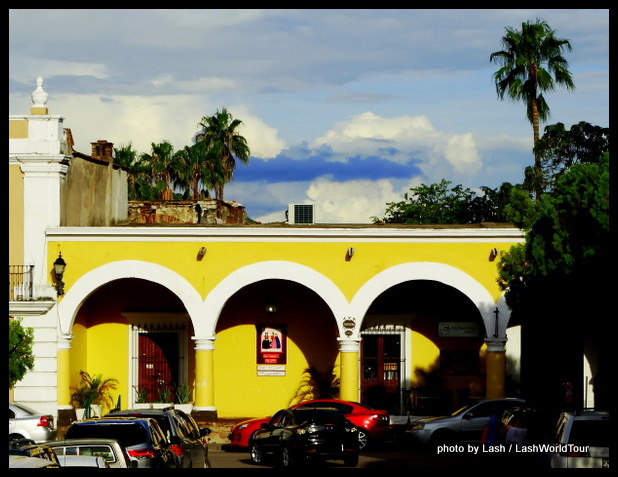
beautiful building in central Alamos
Not surprisingly, Alamos has several gorgeous small colonial hotels set in renovated original buildings. Most are located near the main plaza, perfectly convenient for exploring the town, enjoying local restaurants & cafes and the market.
With its compact center, blocks full of stunning historic buildings, central market, numerous food stalls and restaurants, mirador and quaint museums, Alamos is a delightful and easy town to visit for several days.
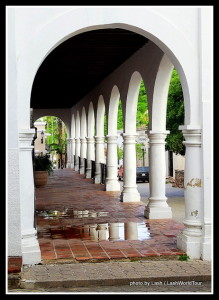
poritco-ed hallway in Alamos
The only hitch is getting to Alamos, at least if you’re going by public transportation. Since it’s up in the hills, off the main north-south highways through Sonora and Sinaloa states, you’ll have to take at least two buses, no matter where you’re coming from.
The only buses accessing Alamos originate in tiny Navojoa town. The closest big cities are Obregon and Los Mochis, both situated 2-3 hours from Navojoa, and neither of which have much of interest.
So plan on spending one half to one full day getting to Alamos by public buses, depending where you’re staring from.
Once you reach Alamos, though, you can relax and enjoy its laid-back small-town vibe, amazing architecture and stunning mountain setting.
====================================================================
You might also find the following articles useful
My Travel Plans through Sonora
===============================================================


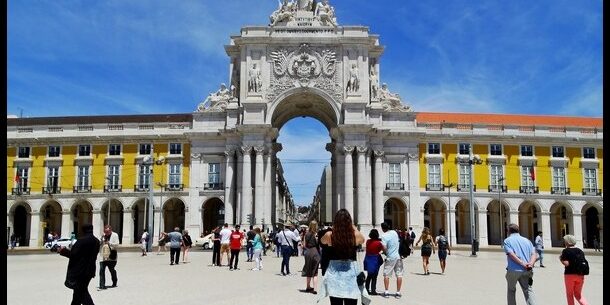


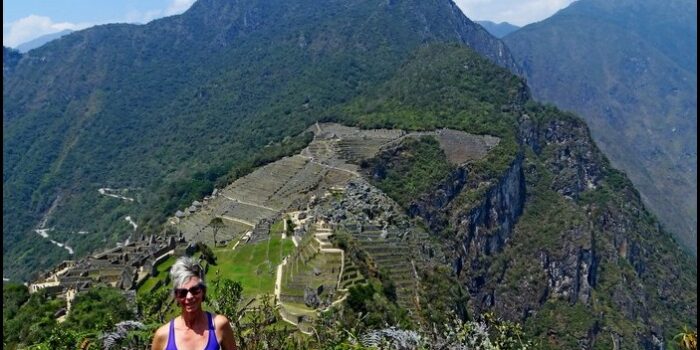


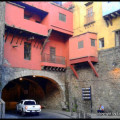


 Hi! I'm Lash, an American nomadic world traveler who's been traveling solo since 1998. I’m passionate about traveling the world nomadically and then sharing it all with you. I hope to inspire you to travel the world, to entertain you with tales from the road, and to help you reach your travel dreams. Welcome!
Hi! I'm Lash, an American nomadic world traveler who's been traveling solo since 1998. I’m passionate about traveling the world nomadically and then sharing it all with you. I hope to inspire you to travel the world, to entertain you with tales from the road, and to help you reach your travel dreams. Welcome! 



